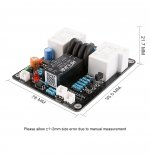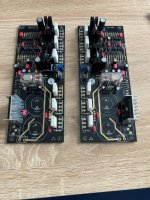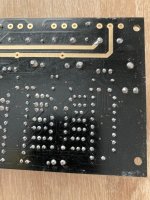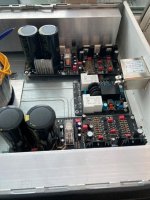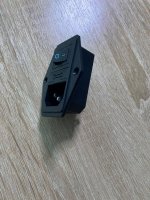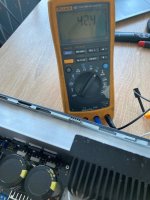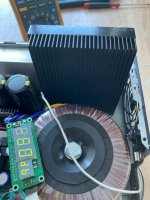Dear vmk2002,The value of this resistor is in fact 22 Ohm, and 33 Ohm is signed on the board. I unsoldered it, and noticed that the gain of the power amplifier dropped (it became equal to 1). I wondered if it was possible to select it in such a way as to obtain a gain that would result in a minimum of distortion and less noise in the absence of a signal (note that it is practically impossible to hear noise in the absence of this resistor, even if we put our ear close to the speaker membrane). Why don't the Chinese depict this resistor in the diagrams?
Your schematics is inaccurate Paroxod is right.
1. Look at your schematics and
2. Look at my incomplete schematics shown below
3. At the bottom of my incomplete schematics there is a resistor denoted with R22
Now use your multimeter and you can establish that:
1. Two ends of R2 and R11 (both 47 Ohm ) from my schematics are interconnected
2. Connection among R2 and R11 is connected to R22 (33 Ohm)
3. Other end of R22 is connected to the ground as shown on my schematics.
That indicates that R22 must have value of 33Ohm. The error is on your board replace 22Ohm resistor with 33Ohm resistor.
That's all
I hope that the sound will further improve.
Have a pleasant evening
Attachments
Last edited:
Berlusconi Hello, you recommended the soft start board. How many seconds is the transformer connection delay, I don’t understand the principle of operation, it differs from the one used in Dartzil. Without load, the output is immediately 230v. When the transformer is connected, there are 8-9v on the terminals, but when starting the connection is fast. Different sellers have different denominations of electrolytic capacitors. What does it cost on your board?
Attachments
Good afternoon. I got this board, but could not get it to work properly. I ordered another one and it works great!
https://www.aliexpress.com/item/32982704299.html?spm=a2g0o.9042311.0.0.7ae74c4d3TgcXr
https://www.aliexpress.com/item/32982704299.html?spm=a2g0o.9042311.0.0.7ae74c4d3TgcXr
Hello. I didn’t like that there was practically no delay, and you can turn it off only after 12 seconds. I tried to pick up C and R, but nothing happened. And this link is made on STC15F104W. Works great, delay 2.5-3 seconds.
Did you ever measure the distortion or FFT analysis of the harmonic distortion profile? A square wave won’t show distortions of an amp when playing regular audio which closer to sine wave excitation. It’s easy as all you need is a sound card, a dummy load resistor and REW software. The baseline measurement of an amp is the classic case of 1kHz excitation at 2.83vrms (1W) into 8ohm load and see what the FFT profile looks like. Also a case of about 25w (14.1v rms) into 8ohms is useful as that is about as loud as most people play in home systems.Recently I've heard someone saying "Amplifier that measures good can't sound bad". I am among those who agree with that.
So let's see first the bandwidth of this amplifier. For measurements I have used a board with 8 pairs of genuine 2SA1943/2SC5200. I have also used four 10.000uF/63V Vishay MAL205148103E3 capacitors. The rails were at +/-42,5 V.
For load I have used three 22R/100W resistors (Arcol HS100 22R J) in parallel.
I have warmed up the amplifier for 1 hour before taking measurements.
First I have determined that the amplifier has a ruler-straight frequency response over the entire audible range. Furthermore, the amplifier has -3dB roll-of at 340kHz.
At low frequencies there was no roll-of at all, just speaker protection turned the output off at 1,5Hz.
This can be considered as adequate bandwidth.
I have proceeded with square wave response analysis. It would be pointless to show a series of perfect rectangles indicating adequate square wave response within the entire audible range. Instead, the figure below shows just the initial part of the response to 50Hz square wave. The figure shows rise within 1.25uS followed by constant peak amplitude.
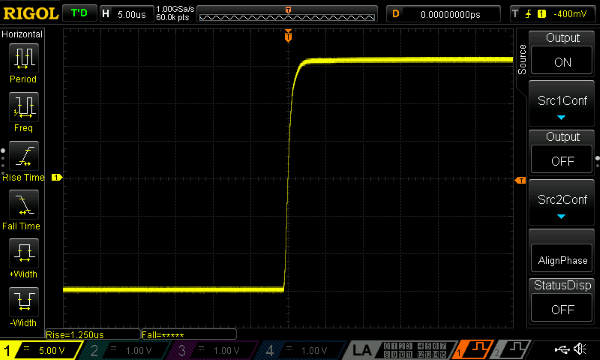
These Aliexpress clone amps can be very cost effective means to have decent sound. But sometimes, they are clones of a schematic that might have an error. As manufacturers will occasionally have a publicly posted schematic (with a strategically placed error) to thwart blatant copying of their designs. Not saying that’s what happened here but I would be curious to see if this amp plays cleanly.
You can see how to measure amps with REW here.
https://www.diyaudio.com/community/threads/howto-distortion-measurements-with-rew.338511/
Thanks X for great suggestions and, more important, for your exceptionally useful contribution to this community. I have learned a lot from you, more than from any other participant.
Besides other things I've learned from you how to perform THD+N measurements. Over the past several months I learn how to increase accuracy and to eliminate the influence of noise from measurement equipment.
Below, I am presenting a single measurement illustrating performance of this amplifier with Arta and REW. This is preliminary measurement of my sixth board, raw, without adjustments and transistors aren't paired, yet. Measurements have been at 10VRMS into 7,3 Ohm dummy load. I have used hardware sound generator at 1 kHz.
Obviously, this amplifier doesn't have extremely low THD measurements, but proportion of individual harmonics indicates why it sounds great: the 2nd harmonic dominates whilst the 3rd and higher harmonics should be inaudible. In my humble opinion, extremely low THD isn't practical advantage at all, below some value it is just a low number without any obvious impact on the sound. For example I've tested several variations on the "blameless" amplifiers and was disappointed because of poor low frequency behavior, despite low THD values, they sounded somehow odd.
When I gather more experience I will join the Alpha Nirvana 39W band.


Besides other things I've learned from you how to perform THD+N measurements. Over the past several months I learn how to increase accuracy and to eliminate the influence of noise from measurement equipment.
Below, I am presenting a single measurement illustrating performance of this amplifier with Arta and REW. This is preliminary measurement of my sixth board, raw, without adjustments and transistors aren't paired, yet. Measurements have been at 10VRMS into 7,3 Ohm dummy load. I have used hardware sound generator at 1 kHz.
Obviously, this amplifier doesn't have extremely low THD measurements, but proportion of individual harmonics indicates why it sounds great: the 2nd harmonic dominates whilst the 3rd and higher harmonics should be inaudible. In my humble opinion, extremely low THD isn't practical advantage at all, below some value it is just a low number without any obvious impact on the sound. For example I've tested several variations on the "blameless" amplifiers and was disappointed because of poor low frequency behavior, despite low THD values, they sounded somehow odd.
When I gather more experience I will join the Alpha Nirvana 39W band.
Thanks for the kind words and for sharing the FFT meausremts of your amp. I agree that ultra low THD is not needed and because the profile is dominant 2nd and monotonically descending higher orders, it should sound very good and 0.02% is not a terrible amount.
славко65 Hello, I ordered another board that you recommended, with discounts it turned out to be 20 dollars. Shipping will only be after February 7th - a holiday in China. The seller wrote that, if possible, he would do everything to send it as early as possible, yes, I have nowhere to rush, while I plug radiators and a transformer into the case, on February 3, the boards will come, there is something to do. If you have both of these products, explain what is the difference and is there a diagram of that what's on the white relays?
Hello everyone. I received the package, it was done well but not washed, version 1.1, although it was 1.0 in the order, I was pleased. I'm slowly assembling it into the case, and I'll probably install a relay volume control with an indication there.
Attachments
Once I tried to put it with a 16 amp filter, I didn’t like it very much. Lost in the sound attack, dynamics. It seems that the amplifier has lost weight twice. Put a normal inlet.
Hello everyone, here I am finishing my version of the A60 with a relay volume control, temperature protection and much more. The case will be completed and painted. Criticize, ask questions.
Attachments
-
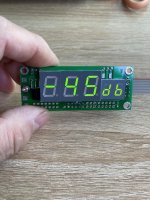 IMG_0214.JPG139.5 KB · Views: 235
IMG_0214.JPG139.5 KB · Views: 235 -
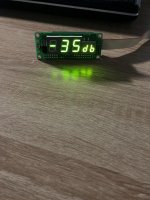 IMG_0216.JPG116.8 KB · Views: 259
IMG_0216.JPG116.8 KB · Views: 259 -
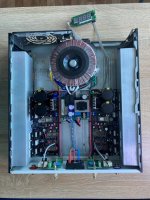 IMG_0217.JPG161.8 KB · Views: 265
IMG_0217.JPG161.8 KB · Views: 265 -
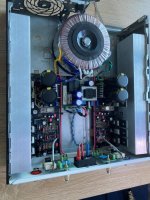 IMG_0218.JPG150 KB · Views: 273
IMG_0218.JPG150 KB · Views: 273 -
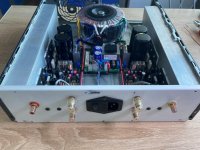 IMG_0219.JPG114.4 KB · Views: 255
IMG_0219.JPG114.4 KB · Views: 255 -
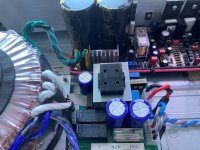 IMG_0220.JPG110 KB · Views: 256
IMG_0220.JPG110 KB · Views: 256 -
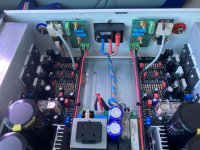 IMG_0221.JPG121.3 KB · Views: 254
IMG_0221.JPG121.3 KB · Views: 254 -
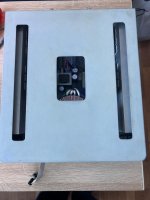 IMG_0222.JPG91.5 KB · Views: 256
IMG_0222.JPG91.5 KB · Views: 256 -
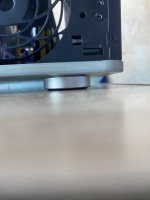 IMG_0223.JPG54.8 KB · Views: 236
IMG_0223.JPG54.8 KB · Views: 236
Hello dear Paroxod!
Great build, very fine design that illustrates advantages of a board that comprises everyrhing, including power supply, servo and speaker protection, separate for each channel. According to my meassurements this amplifier has great potential. It both meassures and sounds great. Besides, your build also looks great, reflects great deal of craftmanship and patient steady work. When I have started dealing with diy audio hobby I was aware that I can not re-invent components, but, for me, the real fun is in integrating components into a device that sounds good and also looks good.
You're doing a great job indeed.
I am looking forward to hear more about the progress of your project. How it sounds? Are there any problems with hum?
Meanwhile, I wish you lots of fun with this fine amplifier
Great build, very fine design that illustrates advantages of a board that comprises everyrhing, including power supply, servo and speaker protection, separate for each channel. According to my meassurements this amplifier has great potential. It both meassures and sounds great. Besides, your build also looks great, reflects great deal of craftmanship and patient steady work. When I have started dealing with diy audio hobby I was aware that I can not re-invent components, but, for me, the real fun is in integrating components into a device that sounds good and also looks good.
You're doing a great job indeed.
I am looking forward to hear more about the progress of your project. How it sounds? Are there any problems with hum?
Meanwhile, I wish you lots of fun with this fine amplifier
I heated it for 2 hours, set the quiescent current, brought it to 20mV at a temperature of 60. The next day, when it was turned on, 10mV, after 20 minutes 20mV at 60 degrees. For the experiment, I added radiators to each channel, the temperature dropped to 40 degrees, and the quiescent current increased to 25mV. An hour later, at 50 degrees, the quiescent current is 20mV. I think to add radiators - there is a place. By the way, in the volume control controller there are 2 channels for controlling the temperature of the radiators, the sensors are already on their way, I will set the power to turn off at 70-75 degrees. What advice?
Attachments
This size of heat sinks appear to be just fine to achieve excellent sound for normal listening volume, especially when listening to classic music where normal listening level is a bit more moderate, well except for Bethooven or Tschaikowsky, sometimes.Radiators will not be the same as in the photo - this is an example. 😉
I also have been running-in this amplifier at lower power, by keeping it below 60°C. Once the temperature increases, the bias will go down. It is possible to adjust the bias to somewhat higher value, it will decrease to the normal level once the temperature increases. To run it entirely in class A you would need larger heat sinks but you don't have. It sounds just great even in case of running into the AB mode. With larger heat sinks I was able to extract more power from it but 12VRMS seems to me just fine - optimal. The amplifier is still completely in A class operation. Once the music requires more power in fortissimo mode, then nothing matters at all. But even then 2nd harmonic dominates, so nothing to worry about. Also, high dynamics doesn't suffer much as long as it goes into real deep bass and distortion is predominantly pleasant 2nd harmonics.
But be carreful: first make sure that bias goes down with the increase of temperature.
- Home
- Amplifiers
- Solid State
- A60(+) Amplifier. Build this?
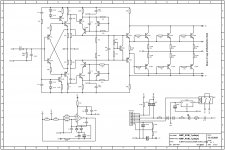
![a60-01[1].jpg](/community/data/attachments/921/921728-2cd79c82099a0df6c089ed521c76480b.jpg?hash=LNecggmaDf)
